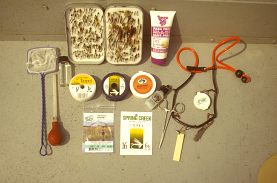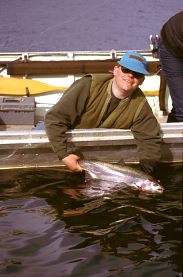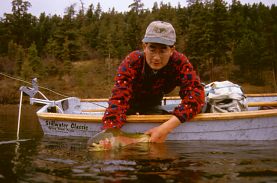
The Stillwater
Fly Fishing Tackle Bag
with
Brian Chan

Ice-off
will be here before we know it so now is the time to get our stillwater
fly fishing tackle bag in order. We all know there is nothing more frustrating
than getting on the water and finding out a piece of equipment does not
work or losing a big fish due to a worn leader that should have been replaced
or retied. Having all the fly fishing gear in order means more time fishing
and hopefully an enjoyable day on the water.
So let's
start with fly lines. At the end of a fishing season it is a good idea
to strip all the fly line off their reel spools, check them for nicks
or cracks and wash them in a mild detergent to remove any dirt, oil or
grease that may have accumulated on them. Loosely coil the lines in 12
to 20 inch wide loops and hang them somewhere cool and out of direct sunlight.
Just prior to re-spooling floating lines use a fly line dressing to lubricate
and improve floatation qualities.

 This
is also the time to replace leaders. Choose a good quality tapered leader
rather than just tying on a piece of straight monofilament. The thick
butt section of a tapered leader allows your fly to turn over at the end
of the casting stroke. Leaders are available in various lengths and tippet
strengths. A floating line being used for chironomid larva and pupa fishing
may have a 16 ft. long tapered leader to which more tippet material can
be added to fish deeper water. 9 and 12 ft long tapered leaders are generally
used with full sinking lines. Check your spools of tippet material left
over from last season. Monofilament does break down and weaken with time
so be prepared to replace them. Spools of tippet are a minor cost compared
to losing the biggest trout of the season. Carry spare leaders and a basic
selection of tippet sizes such as 4, 5, 6, and 8 pound strengths so that
leaders can be rebuilt while on the water. This
is also the time to replace leaders. Choose a good quality tapered leader
rather than just tying on a piece of straight monofilament. The thick
butt section of a tapered leader allows your fly to turn over at the end
of the casting stroke. Leaders are available in various lengths and tippet
strengths. A floating line being used for chironomid larva and pupa fishing
may have a 16 ft. long tapered leader to which more tippet material can
be added to fish deeper water. 9 and 12 ft long tapered leaders are generally
used with full sinking lines. Check your spools of tippet material left
over from last season. Monofilament does break down and weaken with time
so be prepared to replace them. Spools of tippet are a minor cost compared
to losing the biggest trout of the season. Carry spare leaders and a basic
selection of tippet sizes such as 4, 5, 6, and 8 pound strengths so that
leaders can be rebuilt while on the water.
Check over
your fly rods for any cracked ferrules, frayed guide wrappings or loose
corks in the handle. Pay particular attention to the rod guides including
the tip one. Guides do wear and ones with deep grooves or nicks are hard
on fly lines and leaders. Replace worn ones and pick up a spare tip guide
just in case that one is broken off.
Inspect fly
reels for worn pawls, loose parts and clean up any dirt or grease that
may have built up. Lubricate those parts identified by the reel manufacturer.
If spooling up a new reel make sure there is at least 75 yards of 20 pound
test dacron backing on before attaching the fly line. That much backing
should give you enough time to pull the anchor when that really big fish
takes off to the other end of the lake.


The tackle
bag should have some basic tools in it such as a pair of nippers for cutting
monofilament and even trimming up flies. A pair of hemostats or slender
needle nosed pliers are very useful for de-barbing hooks and removing
hooks from fish. They can also be very helpful in removing hooks from
clothing or body parts. A small hook file will salvage that hot fly of
the day when the tip of the barb breaks off. Check your landing net over
for broken mesh and large holes. If the bag needs replacement choose a
soft cotton or soft nylon material with a tight weave or small mesh diameter.
Hard knotted nylon net bags are hard on fish as they remove slime and
scales when the fish is thrashing about. A small hand towel always comes
in handy especially after handling a fish or on those cold wet days.
 Make
sure the tackle bag contains a tube of sunblock and use it. Time on the
water means double exposure to the sun and harmful UV rays because of
the reflection off the water. Anglers should also wear a good pair of
polaroid sunglasses to not only further protect your eyes but allow one
to see through the glare on the water and spot fish otherwise almost impossible
to see. Wearing a wide brimmed hat adds further protection from the sun
and it reduces glare and reflection off the water. Make
sure the tackle bag contains a tube of sunblock and use it. Time on the
water means double exposure to the sun and harmful UV rays because of
the reflection off the water. Anglers should also wear a good pair of
polaroid sunglasses to not only further protect your eyes but allow one
to see through the glare on the water and spot fish otherwise almost impossible
to see. Wearing a wide brimmed hat adds further protection from the sun
and it reduces glare and reflection off the water.
Finally,
carry a small aquarium net to catch insect larva, nymphs, pupa and adults
in and on the surface of the lake. Anglers that are observant not only
catch more fish but have a better understanding of why they were successful.
Brian Chan
riseform@shaw.ca
Brian's
Articles...
|





 This
is also the time to replace leaders. Choose a good quality tapered leader
rather than just tying on a piece of straight monofilament. The thick
butt section of a tapered leader allows your fly to turn over at the end
of the casting stroke. Leaders are available in various lengths and tippet
strengths. A floating line being used for chironomid larva and pupa fishing
may have a 16 ft. long tapered leader to which more tippet material can
be added to fish deeper water. 9 and 12 ft long tapered leaders are generally
used with full sinking lines. Check your spools of tippet material left
over from last season. Monofilament does break down and weaken with time
so be prepared to replace them. Spools of tippet are a minor cost compared
to losing the biggest trout of the season. Carry spare leaders and a basic
selection of tippet sizes such as 4, 5, 6, and 8 pound strengths so that
leaders can be rebuilt while on the water.
This
is also the time to replace leaders. Choose a good quality tapered leader
rather than just tying on a piece of straight monofilament. The thick
butt section of a tapered leader allows your fly to turn over at the end
of the casting stroke. Leaders are available in various lengths and tippet
strengths. A floating line being used for chironomid larva and pupa fishing
may have a 16 ft. long tapered leader to which more tippet material can
be added to fish deeper water. 9 and 12 ft long tapered leaders are generally
used with full sinking lines. Check your spools of tippet material left
over from last season. Monofilament does break down and weaken with time
so be prepared to replace them. Spools of tippet are a minor cost compared
to losing the biggest trout of the season. Carry spare leaders and a basic
selection of tippet sizes such as 4, 5, 6, and 8 pound strengths so that
leaders can be rebuilt while on the water.  Make
sure the tackle bag contains a tube of sunblock and use it. Time on the
water means double exposure to the sun and harmful UV rays because of
the reflection off the water. Anglers should also wear a good pair of
polaroid sunglasses to not only further protect your eyes but allow one
to see through the glare on the water and spot fish otherwise almost impossible
to see. Wearing a wide brimmed hat adds further protection from the sun
and it reduces glare and reflection off the water.
Make
sure the tackle bag contains a tube of sunblock and use it. Time on the
water means double exposure to the sun and harmful UV rays because of
the reflection off the water. Anglers should also wear a good pair of
polaroid sunglasses to not only further protect your eyes but allow one
to see through the glare on the water and spot fish otherwise almost impossible
to see. Wearing a wide brimmed hat adds further protection from the sun
and it reduces glare and reflection off the water.